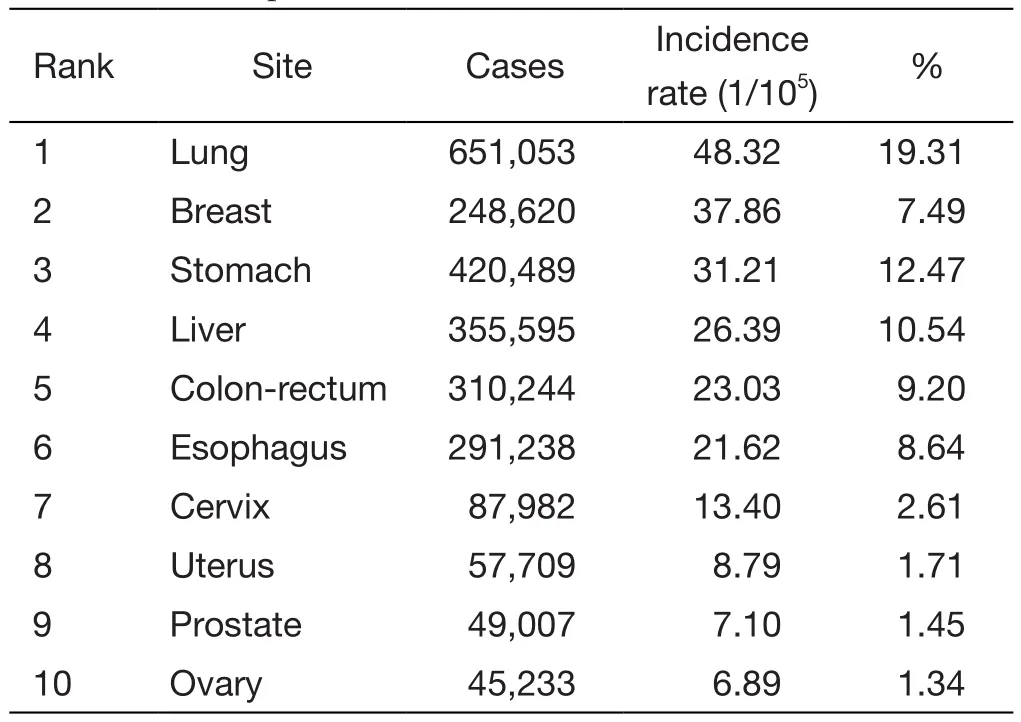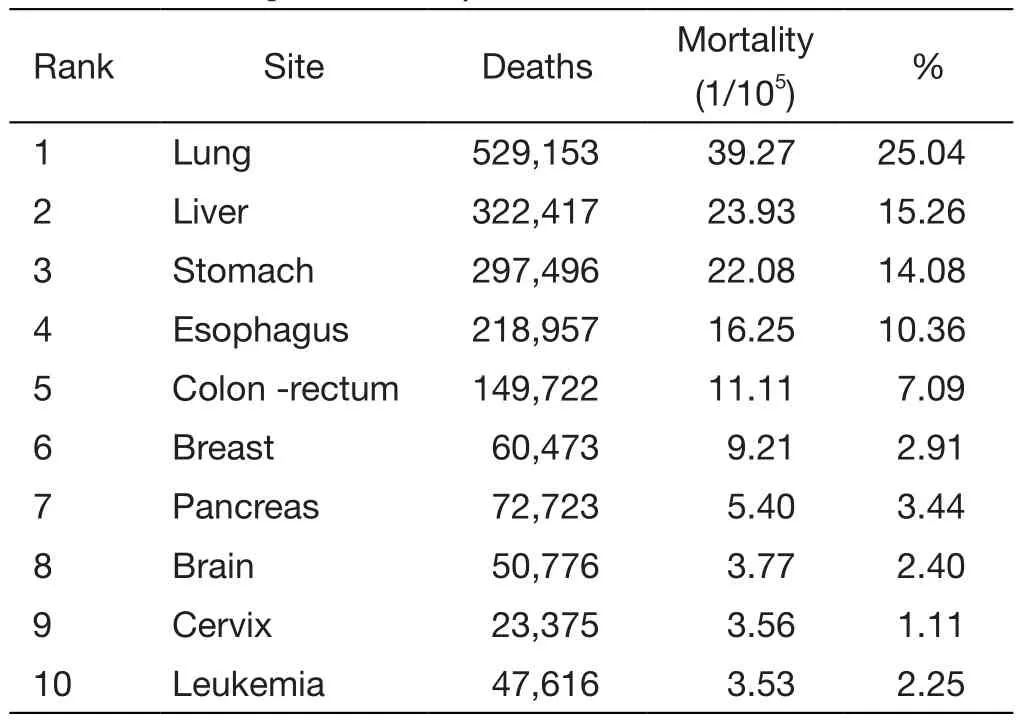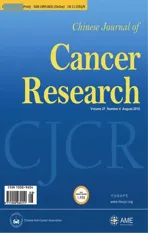Chinese Anti-Cancer Association as a non-governmental organization undertakes systematic cancer prevention work in China
2015-01-08TingtingXu
Tingting Xu
Tianjin Medical University Cancer Institute and Hospital,Chinese Anti-Cancer Association,National Clinical Research Center for Cancer,Tianjin 300060,China
Introduction
A non-governmental organization (NGO) generally refers to an organization that operates independently from any government.Though it may receive funds from a government,it operates without oversight or representation from that government.NGOs,sometimes called civil societies,are organized in community,national and international levels to serve specific social or political purposes,and are cooperative,rather than commercial,in nature (1).
The 13thNational Conference on Civil Affairs in 2012 pointed out that the government is no longer the only power center for the society,and that NGOs and the private sectors may take over different levels of power (2).The 18thNational Congress of the Communist Party of China(CPC) proposed “to accelerate the formation of modern social organization mechanism with characteristics such as separation between the government and enterprises”,and “to fully exert the function of the basic masses in participating social management” (3).In other words,social organizations,as carriers that undertake certain government functions,participate in social governance and public service under the guidance of national policies.
Taking the Chinese Anti-Cancer Association (CACA)for instance,it is a non-governmental and non-profit organization in the field of oncology in China.The mission of CACA is to increase the cancer survival rate,decrease the incidence and mortality rates,and improve cancer control in China.There are currently 42 affiliated professional societies,30 local anti-cancer associationsacross the nation,and 46 membership organizations,with over 40,000 members in total.

Table 1 The top 10 incident cancers in China,2011

Table 2 The top 10 mortality cancers in China,2011
Current status of cancer prevention and control in China
The world cancer incidence has been increasing at the rate of annual average of 3-5% for 30 years (4).Cancer has become the fi rst leading cause of death in the world.2014 Global Cancer Report (5) shows that nearly half of the new cancer cases occur in Asia,mostly in China,and China’s new cancer cases ranked on the top.
Chinese cancer incidence and mortality rates
Three national surveys on the causes of death display that the proportion of cancer in causing death increases from 10.13% in 1970s to 22.32% in 21stcentury,and the mortality rate has been increased from 73.99/100,000 to 135.88/100,000 (6).The reasons for a higher mortality rate include population aging,microbe infection,smoking,unhealthy diet,less exercise,and obese increase (7).Since the national program of cancer registry was launched by the Ministry of Health of China in 2008,the National Central Cancer Registry (NCCR) of China has been publishing cancer statistics annually based on the data collected from cancer registries (8-11).NCCR 2011 statistics show that lung cancer is the highest incidence cancer with an incidence rate of approximately 20%.Breast,stomach,liver,and colorectum cancers are the second highest incidence cancers (Table 1).Meanwhile,lung cancer is the highest mortality cancer.About 529,153 deaths result from lung cancer each year.Liver,stomach,esophagus and colorectal cancers ranked behind (Table 2) (11).
Strategies and policies for cancer control
National Office for Cancer Prevention and Control Research,which is mainly responsible for conducting,organizing,and leading national cancer prevention research,was established in 1969.In 1980s,the first prevention outlineNational Cancer Prevention Planning (1986-2000)was issued (12).After that,Cancer Prevention and Control Planning Outline in China (2004-2010) was published by the Ministry of Public Health of China (now renamed as“National Health and Family Planning Commission of the People’s Republic of China”) in 2003,and it formulated concrete objectives including improving cancer registry system,promoting health education,strengthening etiological prevention and intervention,implementing early diagnose and treatment,and pursuing Chinese National Comprehensive Cancer Network (NCCN).It also clarifies 8 types of cancers,such as lung,liver and stomach cancers,as priorities for next-step work (13).In 2012,the Ministry of Public Health of China (now renamed as “National Health and Family Planning Commission of the People’s Republic of China”) jointly worked with 15 government departments to conductChinese Chronic Disease Prevention and Control Planning (2012-2015),which raised to carry out early diagnosis and treatment in 30% of highest risk regions.Simultaneously,policies concerning tobacco control,vaccination,and healthy lifestyle like reasonable diet and moderate exercise have also been issued (14).
Implementing early diagnoses and treatment strategy in high risk regions is a main content of cancer prevention and control.The screening of stomach,lung,colonrectum,breast,cervix,and pancreas cancers has been applied respectively among the general population in high risk regions.Some examples are esophagus screening in Lin County,Henan Province,stomach screening in Linqu,Shandong Province,and nasopharynx screening in Guangdong and Guangxi Provinces (15).Since 2012,a free colorectal cancer screening has been carried out for three consecutive years in Tianjin,covering the permanent residents at the age of 40-74 years old.A total of 2.15 million residents participated in this screening project,130,000 of whom belong to high-risk population.The screening has been listed as one of the twenty popularity-winning projects by Tianjin Municipal Government (16).Based on real case results,the strategy of early diagnosis and treatment in cancer control has decreased the incidence and mortality of cancer in high risk regions,for instance,the obviously descending trend of mortality on liver cancer in Qidong,and on esophagus cancer in Linzhou and Cixian (17).
Role of cancer NGOS in promoting cancer prevention and control
Cancer is not only a medical issue,but also a social,economic,and political issue.Life and death decisions about cancer are made every day not just in the doctors’ offices but also in the offices of policy-makers.American Cancer Society (ACS) made a 6 month market research on NGOs and civil society in ten countries such as Brazil,Chile,and Mexico in Latin America.The research found that cancer control NGOs in developing countries,through capacity building in areas such as fundraising,volunteer recruitment,and cancer control advocacy,mobilize civil society to work together and advocate governments in their countries to develop policies to address the growing cancer burden (18).Established in 1933,the Union for International Cancer Control (UICC),is the oldest and most well-known cancer control society in the world.It is devoted to promote all the aspects of the campaigns worldwide against cancer in order to eliminate cancer as a major life-threatening disease for future generations.In order to attain its objectives,UICC mainly works on: (I) acting as custodian of the World Cancer Declaration and subsequent equivalent documents;(II) encouraging and fostering global advocacy,education and training of health professionals and volunteers engaged in cancer control and research,and public engagement in cancer control; and (III) advising in the formation and strengthening of local,national or regional cancer organizations (19).As an observer member,UICC was invited by World Health Organization (WHO) to attend the World Health Assembly,to jointly conduct global cancer control strategy (20).
NGOs in Australia are good examples to display the significant role of NGOs in cancer control.Cancer Council Australia (CCA) is the nation’s peak non-government cancer control organization,which is the largest health charity and the biggest independent funder of cancer research.CCA represents national interests of member bodies,Australia’s State and Territory Cancer Councils.They advise best practices concerning policy promotion and fundraising activities,and minimize the threat of cancer to Australians through successful prevention,best treatment and support (21).
In Asia,Malaysian NGOs are actively working on national cancer control.National Cancer Society of Malaysia,National Cancer Council,and Cancer Link and Rotary Clubs keep organizing activities such as health education,cancer counselling,psychiatric and psychology support,social welfare,and holding national and international class academic cancer conferences.These NGOs publish periodicals to help patients and the public realize the symptoms of early stage of cancer and how to get the best treatment.Besides,Malaysia has hospice care organizations which are affiliated with national hospice care organizations.These organizations aid stage III patients to get family care,psychology counselling,education,and relieve the pain (22).
CACA undertake systematic work on cancer prevention in China
CACA is a first-class national NGO in China,which is affiliated with China Association for Science and Technology(CAST).Since its establishment in 1984,CACA has made great contribution to Chinese cancer control,particularly in implementing screening programs,promoting advocacy campaigns,and accelerating profession trainings.
Taking cancer screening projects with Chinese governments
From 2008 to 2009,CACA conducted the pervasive Breast Cancer Screening Project Involving Urban Women in China,which was entrusted by the Ministry of Public Health of China (now renamed as “National Health and Family Planning Commission of the People’s Republic of China”).Fifty-three working places were set up,a total of 910,000 people were diagnosed,and 466 breast cancer patients were diagnosed.From 2009 to 2011,CACA completed the Breast Cancer Screening Project Involving Rural Women.This project involved 146,000 women from 30 provinces and 200 counties,and 636 people were diagnosed as cancer patients.
From 2008 to 2010,under the leadership of CACA,Tianjin Medical University Cancer Institute and Hospital jointly worked with Beijing Haidian Children and Women Hospital,Liaoning Province Cancer Hospital,Feicheng People’s Hospital and the Third Hospital of Nanchang to carry out the first round cancer screening project-the Chinese Female Breast Cancer Screening and Optimization Scheme of Multi-Study.A total of 35,000 women aging from 45-65 years old participated and 102 cases of breast cancer were detected.The detection rate was about 294/100,000 and it was 5 times higher than that in 2008.
Since 2012,CACA has been successfully applied for Poor Area Cancer Relief Pilot Project sponsored by the Ministry of Civil Affairs in consecutive years and obtained 2 million Yuan in total.CACA,as a Chinese social organization,took on functions left by the government.For example,CACA organized domestic well-known experts to provide breast and cervical cancer screening services for women from poor areas in Jiangxi and Guizhou.In fact,the project aimed at promoting the standard treatment guidelines in poor areas and training a professional oncology medical team.
Collaborating with international NGOs to raise public awareness on cancer prevention
David Hill,the former President of UICC made a public survey about “cancer = death?”,and 42 countries and over 40,000 adults participated in the survey.The survey showed that 1/4 of the people investigated consented that “cancer =death”,43% of whom were Chinese (23).Chinese people are generally unaware of how to prevent and treat with cancer and quite a few people have misunderstandings about cancer.
Based on the research results,CACA has been jointly working with UICC to launchWorld Cancer Day Eventsince 2008.The World Cancer Day is marked on February 4thand different kinds of activities,such as physical examination,psychology consulting,and science advocacy events,are held on that day each year.The aim is to raise awareness of cancer control across the whole world,and improve people’s life quality.Moreover,“4.15 National Cancer Week” advocacy campaign,launched by CACA in 1995,has become a brand event held by the nation in each year.During the week of April 15th,CACA holds various activities such as marathon,patients care,and science dissemination seminar to public.Over millions of people have been benefited and millions of prevention materials were handed out.
Strengthening academic professional training
In order to improve the treatment skills of cancer professionals,CACA actively pursues continued medical education to update knowledge and technology concerning cancer,so that the cancer diagnosis and treatment level of Chinese oncology professionals could be improved.CACA has held more than 100 continued medical education training courses in recent 5 years.Now 60,000 people have been benefited.Since 2013,joint collaborated with UICC,CACA has been launched international medical education program.The program aims at providing overseas working opportunities for young academic person whose age is between 30 to 45 years old.Through 3 to 12 months international training,young professionals obtain their insights to improve clinical treatment skill and research ability.
Besides,affiliated professional societies have published series of standard cancer diagnosis and treatment guidebooks,and held tens of new progress training classes on cancer treatment.Meanwhile local anti-cancer associations also hold training classes for grass-root professionals in order to improve regional cancer treatment skills.
Experience and outlook
We conduct case study by selecting CACA as the NGO case to investigate the influence NGOs exert on systematic cancer prevention work in China.We found that during the past 30 years,CACA,as a NGO,plays an important role in strengthening government leadership on cancer prevention and control,developing and optimizing cancer professional team,reducing cancer incidence and mortality,and improving public health level.
The case study implicates that: (I) NGOs should work closely with government and actively apply for projects and funding; (II) NGOs need to promote the Chinese NCCN guidelines and conduct series of cancer treatment guidebook to standardize cancer professional treatment;and (III) NGOs have responsibility to disseminate scientific cancer prevention and treatment knowledge to public so as to raise public concern.
Acknowledgements
I would like to extend my sincere gratitude to Professor Ying Wang,for her instructive advice and constructive suggestions on my article.I am deeply grateful for her help in the completion of this article.
Footnote
Conflicts of Interest:The author has no conflicts of interest to declare.
1.Non-governmental organization.Wikipedia,2015-06-15.Available online: https://en.wikipedia.org/wiki/Nongovernmental_organization
2.Li LG.The speech of the 13th national conference on civil affairs.Zhongguo Min Zheng 2012:01:12-3.
3.Ling HB,Shen X.The role of government on promoting the innovative development of society organizations.Theory Construction 2013:16-22,109.
4.Hao XS,Wei YQ.Oncology.Beijing: People’s Medical Publishing House 2010:12.
5.Stewart BW,Wild CP.World Cancer Report 2014.IARC Nonserial Publication,2014.
6.Chen Z.The third national death survey report.Beijing:Peking Union Medical College Publication House 2008:11-2.
7.Anand P,Kunnumakara AB,Sundaram C,et al.Cancer is a preventable disease that requires major lifestyle changes.Pharm Res 2008;25:2097-116.
8.Chen W.Cancer statistics: updated cancer burden in China.Chin J Cancer Res 2015;27:1.
9.Chen W,Zheng R,Zhang S,et al.Report of incidence and mortality in China cancer registries,2009.Chin J Cancer Res 2013;25:10-21.
10.Chen W,Zheng R,Zhang S,et al.Annual report on status of cancer in China,2010.Chin J Cancer Res 2014;26:48-58.
11.Chen W,Zheng R,Zeng H,et al.Annual report on status of cancer in China,2011.Chin J Cancer Res 2015;27:2-12.
12.Zeng HM,Chen WQ.Cancer epidemiology and control in China: state of the art.Progress in Chemistry 2013;25:1415-20.
13.Cancer Prevention and Control Planning Outline(2004-2010).Disease Prevention and Control Bureau,MOH.Available online: http://www.caca.org.cn/system/2009/03/18/010022193.shtml
14.National Health and Family Planning Commission of the People’s Republic of China.National Program for Chronic Disease Control and Prevention (2012-2015).Available online: http://www.nhfpc.gov.cn/zhuzhan/wsbmgz/201304/b8de7b7415ca4996b3567e5a09e43300.shtml
15.Wu F,Lin GZ,Zhang JX.An overview of cancer incidence and trend in China.China Oncology 2012;21:81-5.
16.Liu DA.Tianjin completed the fi rst round colon cancer screening.Yi Xue Lun Tan Wang,2015-02-26.Available online: http://www.cmt.com.cn/detail/732909.html
17.He YT,Yang L,Hou J,et al.The prevalence trend of esophageal in Cixian of Hebei Province and Linxian of Henan Province.Cancer Research on Prevention and Treatment 2001;28:485-6.
18.Durstine A,Leitman E.Building a Latin American cancer patient advocacy movement: Latin American cancer NGO regional overview.Salud Publica Mex 2009;51:s316-22.
19.Zhang M.Union for International Cancer Control and Chinese Board of Director.China Oncology 2010;19:626-9.
20.Union for International Cancer Control.68th World Health Assembly: Live Update.2015-05-26.Available online: http://www.uicc.org/68th-world-health-assemblylive-update
21.Shi JF,Yu XQ.An overview of cancer prevention and control in Australia.China Oncology 2011;20:318-25.
22.Dai LP,Zhang YG.An overview of cancer prevention and control in Malaysia.China Oncology 2011;20:786-92.
23.Hill D.The Survey of Cancer is Equal to Death? The presentation on 21stWorld Cancer Congress,2010.
杂志排行
Chinese Journal of Cancer Research的其它文章
- Immunotherapy for pancreatic ductal adenocarcinoma: an overview of clinical trials
- Surgery for oligometastasis of pancreatic cancer
- Pancreatic cancer surgery: past, present, and future
- Surgical treatment of pancreatic head cancer: concept revolutions and arguments
- Early detection of pancreatic cancer
- The crown jewelry of the surgeries for pancreatic cancer
